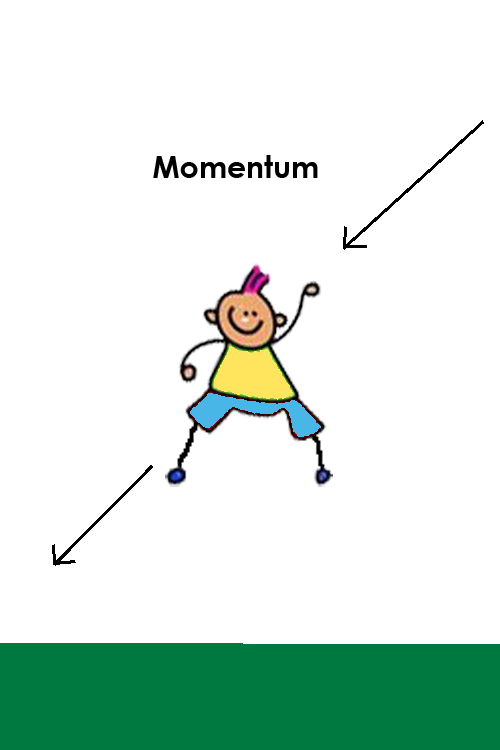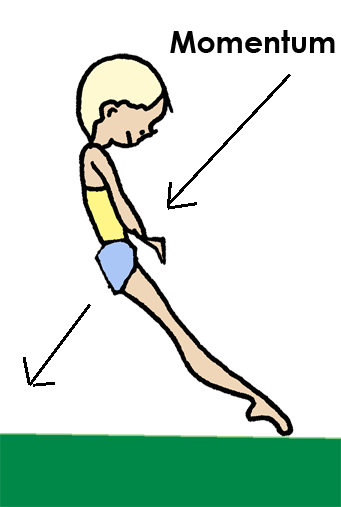Teaching Children to Fall safely
Teaching children to fall safely is fundamental to a lot of sports and physical activity, not just gymnastics! We are going to cover what happens when you hit the ground, and how we can minimize / eliminate injury.
The forces at play (science content)
Falling straight down - 'The Motorbike'
Falling forwards
Falling backwards
Hit the ground running
Conclusion
The Forces At Play
Warning - Science Content!
In a collision, an object experiences a force for a given amount of time that results in its mass undergoing a change in velocity (i.e., that results in a momentum change). http://www.physicsclassroom.com/Class/momentum/u4l1b.cfm
When we are talking about landings, the object is our body. We are either attempting to bring our body to a complete stop when we hit the ground, or we can hit the ground running (like when an aeroplane lands).
The amount of force that our body experiences (the impact that we feel) when it hits the ground is inversely proportional to how long the collision lasts for.
An object with 100 units of momentum must experience 100 units of impulse in order to be brought to a stop. Any combination of force and time could be used to produce the 100 units of impulse necessary to stop an object with 100 units of momentum. This is depicted in the table below.
Combinations of Force and Time Required to Produce 100 units of Impulse
| Force | Time | Impulse |
|---|---|---|
| 100 | 1 | 100 |
| 50 | 2 | 100 |
| 25 | 4 | 100 |
| 10 | 10 | 100 |
| 4 | 25 | 100 |
| 2 | 50 | 100 |
| 1 | 100 | 100 |
| 0.1 | 1000 | 100 |
Observe that the greater the time over which the collision occurs, the smaller the force acting upon the object. Thus, to minimize the effect of the force on an object involved in a collision, the time must be increased.
http://www.physicsclassroom.com/class/momentum/Lesson-1/Real-World-Applications
A modern car has several mechanisms for reducing the force felt by the occupants during a collision. These mechanisms act to increase the time that the collision takes. Crumple zones act to increase the duration of a collision, and air bags act to extend the time taken to stop the driver and passenger. Dash boards are padded, so that if the driver of passenger should hit the dash board, then the padding acts to extend the duration of the collision.
Falling straight down

Let's say we are falling straight down. We have a lot of vertical momentum, but very little or no forwards / backwards momentum. When we hit the ground, in order to reduce the impact felt we need to increase the time our landing takes. We can do this by using a combination of our ankles, knees, and hips.
As we hit the ground, first our toes touch, then our heels. This gives us our first point to reduce the impact felt.
Next is the most important - our knees - as we land our knees need to bend, they can bend either a little bit, or a lot depending on how much force we hit the ground with.
Last of all is our hips. We stick our bottom out a bit so that we keep our balance, our legs are also apart a bit to give us a wider base of support, thus also helping us to keep our balance.
In gymnastics this is commonly referred to as a motorbike shape.
Please note that the speed (velocity) that we hit the ground with is also very important. If we are falling from a great height, then we will have built up a lot more speed when we hit the ground, and thus will require a greater impulse in our collision with the ground. Our poor knees can only take so much force! When we start jumping off or falling from large heights, we also require a way to reduce our velocity (such as a parachute). Don't go jumping off the roof of a 10 story building and expect a motorbike to save you! You have been warned!
Falling Forwards

A motorbike shape is great if we are falling straight down, or only have a small amount of momentum carrying us forwards or backwards, but what if we are falling on an angle? Our momentum is not only carrying us down towards the ground, but also forwards.
This scenario occurs when:
- We have tripped over and are falling towards the ground
- We are running straight at an object like a wall
- It is either not possible to keep our balance in our motorbike and we are going to fall again
What to do?
When we fall on our feet, we can use our knees to increase the duration of the landing and thus reduce the impact felt by our body. Likewise, if we are falling forwards we can use our arms. Our hands can catch us, and our elbows bend to reduce the impact felt by our body.
Here's the important bit – when we hit the object with our hands, our arms need to be already bent a little bit. If your elbows are 'locked' then the force of the landing will travel straight to your collar bone (clavicle) and depending on how much force there is, can result in a fracture. (Some anatomy here http://orthoinfo.aaos.org/topic.cfm?topic=a00072)
So it is important to practice falling forwards and bending our arms to catch us, the action of bending our elbows should be automatic so we can avoid fracturing our collar bone (clavicle).
Practicing falling forwards
When we first start practicing falling forwards, the first thing we need to do is reduce the impulse required to stop us during our impact. We can do this by reducing the velocity of our fall. I normally start teaching children to fall forwards by starting on their knees – less height = less speed (gravity!).
Next we need to think about what happens if the student hits the ground with their elbows locked. We should already be starting by falling from a height that would not cause any injury, but by using a padded mat we can also help to further reduce the shock felt by the collar bone if the student fails to have bent elbows when they hit the ground.
Starting on our knees, we have our arms in front of us, our arms are slightly bent. Falling forwards, our hands catch us and we use our arm muscles to slow us down, and we finish holding ourselves off the ground, with our head turned to the side so we don't squash our nose.
Once students have mastered falling from their knees, we can introduce falling forwards onto the ground from our feet. **Safety Tip** now the students are higher up, they will have a greater velocity when the hit the ground. I normally use a crashmat or a foam wedge when they first start doing this, again thinking about 'what if they don't bend their arms'. A soft surface to fall on will increase the duration of the impact, and thus reduce the force felt by the body.
Now they have the hang of it, you can have some fun with it. Think about not only falling onto the floor, but running into walls. The same concept of hands catching and bending your arms still applies; again, you may want to put some padding up.
Falling Backwards

One of the most common causes of broken bones in children is from falling over backwards. With no knowledge of how to fall, when we fall backwards we instinctively put our hands back to catch us. Our body goes into autopilot, and sacrifices one bone (our wrists) in order to save another (our back and head).
When we fall backwards, we cannot use our hands to catch us and bend our elbows to any great effect (try it yourself – try doing push-ups in a back support, there's not much of a crumple zone there). So when we fall backwards we need to use a different technique – the springs don't work any more.
Another effective way that we can increase the duration of our impact, and decrease the force is by rolling. We can roll forwards if we have forwards momentum, backwards if we have backwards momentum, or even sideways!
Teaching falling backwards
The following already have minimal velocity, so you should not need thick crashmats, but as above with falling forwards, you may want to use a soft surface, either a mat or soft grass. Try to avoid doing this on bare floorboards or concrete, it hurts the kids with little body fat.
Step 1
Start by sitting on the ground with your legs tucked up on your chest. Keeping your arms in front of you, roll onto your back, then back up onto your bottom. Repeat. Your hands are not allowed to touch the ground. If you have too much speed, then you can use your arms to 'slap' the ground behind you so you don’t roll over.
Step 2
Starting in a motorbike shape, stick your bottom out far enough so that you fall backwards. Roll back as in step 1.
Note- I generally encourage kids to keep their arms in front of them and not use them. If the arms are out in front, then they can't also be behind their body's hitting the ground first and going snap.
Hit the ground running
Think about when an aeroplane cones into land. It comes in on a shallow angle, touches down, and then applies its brakes to slowly reduce its forwards momentum, eventually coming to a stop. We are trying to replicate this with our bodies.
This type of fall has the longest time to reduce our impact, but we are now also only using one leg instead of two, and we use them one after the other.
This action is normally automatic. Think about what happens when you fall off a skateboard, or mess up when you go roller skating for the first time.
The action of walking is something that we have been doing since we were babies, so this is one of the easiest falls to practice.
We are doing a combination of bending our knees to reduce our vertical impact, and using a slow deceleration (running) to bring our horizontal momentum to a gradual stop.
Practice running landings
Jump forwards off a box, bench, or mini-trampoline so that you have forwards momentum. Note that we are jumping for distance, not height! If you don't have forwards momentum, then this will not work very well! Whilst in the air, lift up one leg, either lift the knee up in front of you, or kick towards your bottom with one foot, lean forwards slightly. When you hit the ground, you will fall forwards and transfer your weight onto the foot that was lifted up.
The gymnasts in your class may struggle with this as they have been trained to 'stop' in a motorbike. Asking them to land on one foot and keep moving forwards is like asking a cat to fall on its back.
Conclusion
Take the time to practice falling. You may not eliminate injuries resulting from falls in your playground, but in the heat of the moment you may be giving your students a chance to save themselves!
Gymnastics 4 Hire runs student incursions on falling safely.

